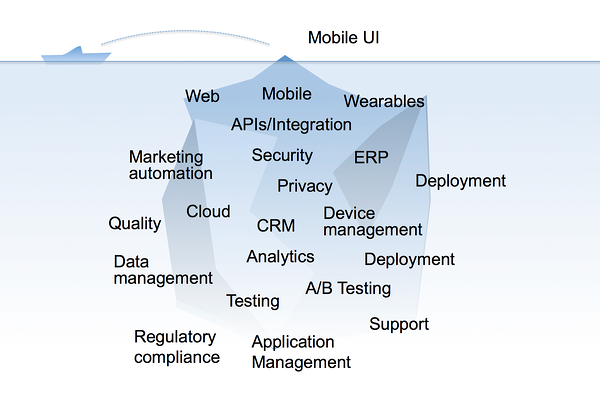I expect that most who work inside of companies and organizations of all types will agree that when customers interact with their organization, what they experience is just the tip of an iceberg with a lot more going on beneath the waterline. What lies beneath includes organizational structure (marketing, sales, service, IT and others), a variety of internal and external business processes and a wide and growing variety of technologies all used to support and delight (or neglect or cause misery to) their customers. Your customers don’t value, don’t know, don’t want to know, and don’t need to know how things work beneath the waterline.
(Note that the use of customer is used in broader B2Me terms including B2C, B2B, B2E customers, students in education, healthcare patients, charitable donors, government constituents and so on.)
The Customer Engagement Iceberg

Historically, we have often entered projects with our clients working beneath the waterline on the adoption of specific new technology and development methods, improvements to business processes, people skills and more. Projects were frequently only focused on one customer touch point. We have found that customer engagement projects are most successful and have the most impact when the project team thinks holistically about customer engagement from the top of the iceberg first, while respecting and leveraging the reality of the capabilities and constraints that lie beneath.
Some of the important above and below the waterline aspects of a well-rounded approach to Customer Engagement strategies and solutions include the following principles:
Design-Led Approach to Innovation
Move toward building the right thing by starting above the waterline to understand what customers really need throughout their journey, both expanded by and grounded in what technology can really accomplish. Bring together diverse interdisciplinary perspectives in a studio culture from within, and outside of, the organization to:
- Think outside of and across the silos beneath
- Talk to customers, collect data and understand real needs
- Share insight on and understand the problems in the context of potential solutions and constraints
- Understand what is necessary versus what is desirable and what priorities and tradeoffs might inform the design and ultimately the technology choices and and execution
And Below the Waterline
Many organizations don’t start customer engagement initiatives by looking both above and below the waterline or across the attract/sell/service cycle at the same time. By starting with the establishment of a vision, then integrating design thinking with technology strategy and a good software development model one can drive projects to both build the right thing and build the thing right. Working in an agile development model across the variety of options, with sound architecture practices helps drive good or great (sometimes not perfect) choices and investments in technology.
Agility (and Discipline) in Project Execution and Investment Decisions
We see success when organizations start with a strategic planning phase that prioritizes decisions collaboratively based on a shared vision for what is the right thing. After the vision is established, you can enable teams and apply agile development practices to drive better outcomes by building incrementally, learning and adapting to the fast pace of change of the market, technology, competition and rising customer expectations. This all must be done while also managing risks and the budget with transparency to guide investments. Driving transparency while communicating and collaborating on business and technology decisions throughout the project leads to stronger and more cost effective outcomes. The recent Summa blog post, "Four Reasons Why Agile Organizations Are Better Equipped To Engage Customers", speaks in more detail to the benefits of agile practices to Customer Engagement initiatives.
Strategic use of APIs and Integrated Systems
More and more applications (especially mobile apps) are built from functionality and use data that is managed somewhere in the silos beneath the waterline. Integration needs and opportunities that lie beneath include considerations of not just technology and applications, but people, business processes and external businesses. More and more value can be provided to customers by eliminating friction in access to silos of information in real-time by leveraging existing and changing ecosystems of information and application programming interfaces (APIs). More and more services are becoming available via public APIs and companies are also seeing value in exposing their services as APIs. There is also fast increasing value and decreasing costs in capturing more data for analytics that are part of a sound strategy for integration. Comparing customer and internal insights to data captured from across a wide set of sources can inform where investments should be made and avoided and also feed future marketing and product strategies.
Constant Vigilance of Security and Privacy Concerns
It is essential to think about the full stack and dependencies between technologies, processes and systems and maintain constant vigilance against the wide range of fast changing threats versus impact to customer experience. There is a need to establish trust without burdening customers with usability challenges. There are also ever evolving regulatory changes around some industries and organizations that impact customer engagement direction. Customers’ demands increase as news breaks each day about another major breach. Small oversights can lead to big disasters. Unchecked complexity can unleash dangerous and unintended exposures.
Front End Design and Development
It probably goes without saying that close to the waterline is user experience design (interaction, information and graphic design) and front end (web and mobile) software development. Strong expertise and capabilities in these areas are necessary ingredients to solutions that engage more and more demanding customers. The rapid changing pace of web and mobile technology options across platforms makes choices in technologies and investments in front end design and development critical to building sustainable solutions.
Data and Analytics
Understanding how your customers are behaving throughout their journey is getting continuously easier and less costly with data capture and analytics capabilities. Developing insights to customer behaviors informs the customer engagement strategy and investment decisions through feedback from real world measurement of results that are evaluated iteratively as changes are made to engagement touch points over time. Big Data and predictive tools allow systems to respond in real time to customer actions and reactions. Data collection and analysis tools should span the internal silos and customer touchpoints to include much more information than web logs of days gone by. Integrating purchasing data, marketing campaign responses, social networking data, service and support interactions and much more will drive more value and sharpen decisions about where to invest (and not) in targeting customers and applying new technology.
Architecture Matters
Last but not least, investing in experienced system and software architects to lead the design and development efforts balances immediate business need while incrementally building toward a customer engagement platform that is sustainable, adaptable and reliable to the fast changing world. Often there are competing architecture goals that need to be understood, balanced and rationalized. Adapting to and correctly embracing fast moving technology changes such as wearables, IOT, mobile, social, and cloud services takes an architect’s eye to quickly assess opportunities and constraints for their use; keeping an eye to the future while leveraging investments of the past. Working incrementally and collaboratively across the organization (business and IT) building consensus on trade-off decisions to deliver value sooner and faster while driving out risks.
Take Aways
The first blog post in Summa’s Customer Engagement blog series, "8 Questions Every Executive Should Ask About Customer Engagement", discusses questions that might be asked of executives at the tip of the iceberg. Accomplishing technology change to engage customers is in many ways easier and less expensive with the fast pace of growth and lower costs of mobile, cloud, connected device and data technologies. Because of the pace of change, the number of options available and the likelihood that a big part of the value can be achieved with currently locked and siloed IT assets it is necessary to start by putting the customer first. Understand what they value and what they want to and can control through design thinking and an outside-in strategy. Then understand and prioritize how to build on top of, integrate, remediate and transform what lies beneath the waterline to get the most value. Vendors focused on point solutions to specific customer engagement capabilities don’t look at the broader perspective and detailed path that considers the legacy or the future. Understanding broad customer needs along with an assessment of the technology and organizational landscape along with familiarity of similar terrain helps guide better decisions to get better outcomes that customers value faster.
Contact us to learn more, or visit our Customer Engagement Page for resources and examples of our customer engagement experience. Also take a look at our Customer Engagement Blog.




